This post was last updated on January 5th, 2024
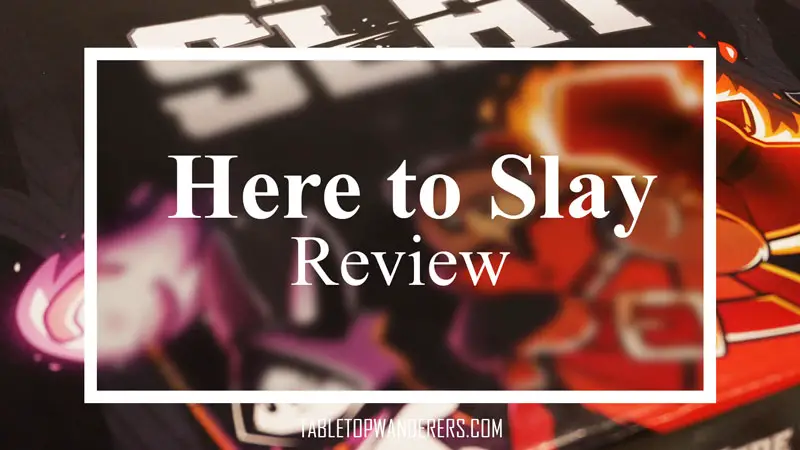
Hi fellow monster slayers and welcome to the review of another board game published by the amazing team at Unstable Games.
After reviewing the beloved Unstable Unicorns, it’s time to give you my honest thoughts about Here to Slay.
This game caught my interest the time I saw the game box. Forming a party of different Hero classes with the goal of slaying monsters? Call me in!
Being a huge fan of roleplaying games and anything related to fantasy land, I couldn’t leave it on the local store shelves.
Sharpen your weapons and follow me through this journey! (To read it with a deep voice pretending it’s not just a game review)
This post may contain affiliate links. If you click through and make a purchase, I will get a commission at no extra cost to you. See our Affiliate Disclosure.
Here to Slay Overview
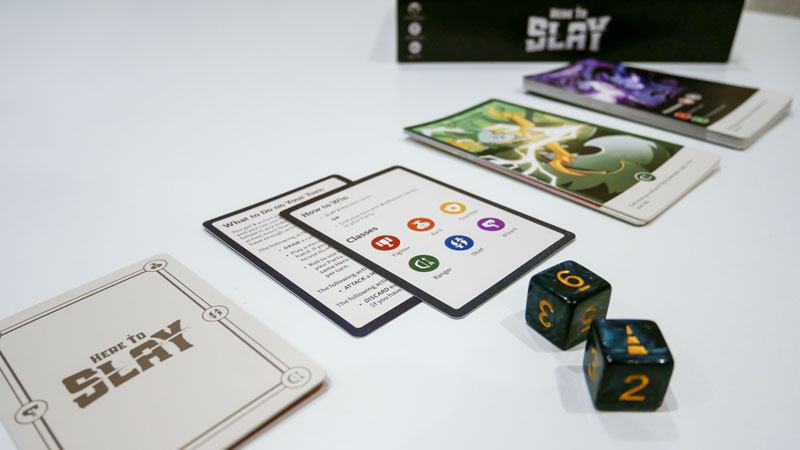
Game Concept
In Here to Slay, you take on the role of a fearless party leader looking to recruit heroes and slay monstrous foes.
Your goal is to either build a party consisting of six different hero classes or slay three terrifying monsters before your opponents do.
Throughout the game, your choices will determine your fate; so, choose carefully and plan your moves to deceive your rivals and win the game.
What’s in the box
- 1 main deck (115 standard-sized cards)
- 6 oversized Party Leader cards
- 15 oversized Monster cards
- 6 rules reference cards
- 2 six-sided dice
Setting Up the Game
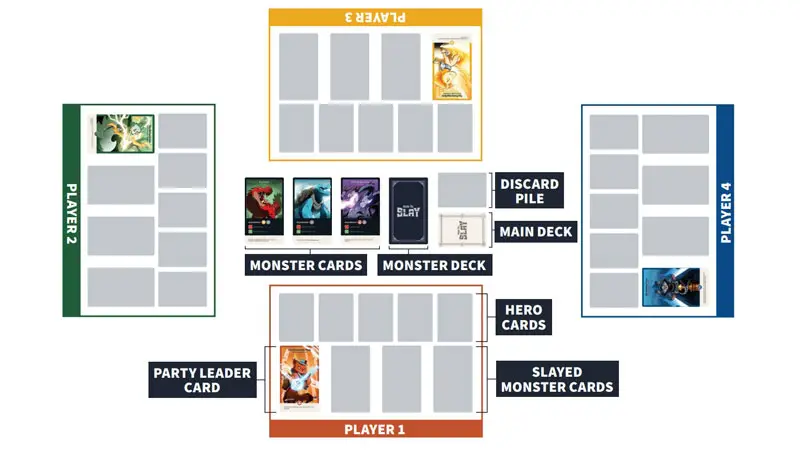
To begin the game, first, sort the various types of cards in the box.
Then, each player should pick a Party Leader oversized card to represent them throughout the game.
You could roll to determine who gets to choose their Party Leader card first, or you could make it a free-for-all and let everyone choose at once.
Another non-official alternative could be to turn the Party leader cards face down and pick randomly.
This is something I do not so rarely in board games and would definitely do if I had already tried all the leaders.
Each player should also take a Rules reference card to have a quick reminder of what you can do during your turn.
Any remaining Party Leader cards and rules reference cards should be put back in the box as they won’t be used for the rest of the game.
Next, shuffle the 115 standard-sized cards and deal five to each player.
Put the rest of the cards face down in the centre of the table to form the Main deck.
Make sure to leave space next to the main deck for a discard pile where you can place cards that are sacrificed, destroyed, or discarded during the game.
Shuffle now the Monster cards and flip the top three face up in the centre of the table. These will be the 3 monsters you’re going to try to slay.
Put the remaining Monster cards face down to form the Monster deck.
How to Play Here to Slay
During the game players take turns following a clockwise rotation as you normally do in board games.
You’ll receive 3 action points to use during your turn and you can use them to perform certain actions in any order you want.
Different types of action correspond to a different cost to perform them.
The cost of any action goes from 1 to 3 points.
The following actions cost 1 action point:
- Draw a card from the main deck.
- Play a Hero, Item, or Magic card from your hand.
If you play a Hero card you can roll the dice for free to use the effect of that Hero card immediately (VERY useful!). - Roll two dice to use the effect of a Hero card in your Party.
Please note that you can’t roll the dice to use the same Hero card’s effect more than once per turn, even if you rolled unsuccessfully the first time.
The following action costs 2 action points:
- Attack a Monster card.
The following action costs 3 action points:
- Discard all the cards in your hand (if you have any) and Draw five new cards.
If you have enough action points remaining, you can perform the same action more than once on your turn.
If a card’s effect tells you to take immediate action, then you don’t need to spend an additional action point to take that action.
Your turn ends either when you have no action points left or when you choose not to take any additional actions.
You can’t use any unused action points in your next turn, so it’s better to use them all each turn.
Winning Conditions
There are 2 ways to win the game:
- Be the first to assemble a Full Party, consisting of a party with 6 different Hero classes.
(your Party leader class counts towards the completion of this goal, so for example, if you chose the Ranger you don’t need to have another Ranger hero in your party to win). - Be the first to Slay 3 monsters before your opponents do. Simple.
Main deck cards
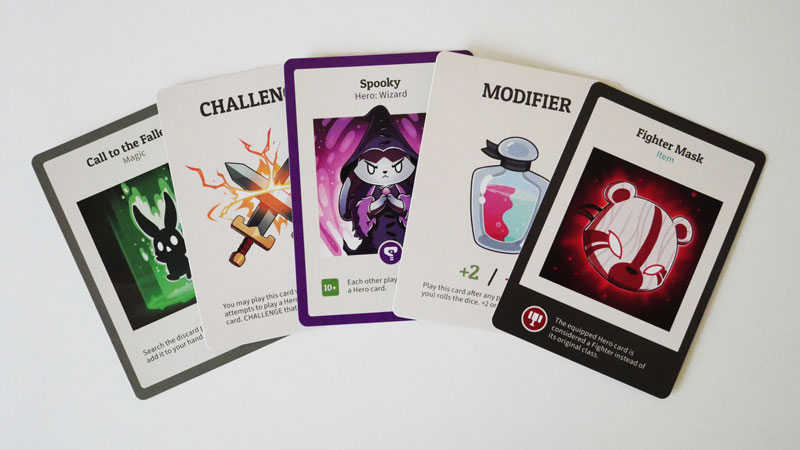
The main deck is made up of 115 standard-sized cards and contains 5 different types of cards:
- Hero cards (48)
- Item cards (15)
- Magic cards (13)
- Modifier cards (25)
- Challenge cards (14)
Hero cards
These are the adventurers that will form your party once recruited (played on the table) and they all come with a class type and an effect.
To use a Hero card’s effect, you must roll the dice and score equal to or higher than the roll requirement for that effect.
When you play a Hero card from your hand, you can immediately roll two dice to use its effect without using any additional action points.
If a Hero card is already in your Party, you can use an action point to attempt to use its effect once per turn.
If you roll unsuccessfully, you won’t get the action point back.
There is no limit to the number of Hero cards you can have in your Party.
Items cards
Item cards are enchanted weapons and objects that can be equipped to your Hero cards.
Most of these cards offer positive benefits, such as bonuses to rolls or protections for the equipped Hero card. However, there are also Cursed Item cards that provide negative effects and can be assigned to enemy Hero cards to give them disadvantages.
Only one Item card can be equipped to a Hero at a time, and you can’t replace an Item card with another.
If a Hero card with an equipped Item is destroyed, stolen, or returned to your hand, that Item is also destroyed, stolen, or returned to your hand.
Magic cards
Magic cards are powerful spells with an effect.
When you play a Magic card, resolve immediately its effect and move it to the discard pile.
If you chose The Cloaked Sage as your Part leader, you’ll get to draw a card each time you play a magic card.
Modifier cards
Modifier cards are special cards that can be used to increase your chances to succeed in doing a certain action.
You can immediately play a Modifier card from your hand when any player (including you) rolls the dice, in order to modify that roll by the amount written on the Modifier card.
Some modifier cards offer the option to choose between a positive or negative number depending on what you’re trying to modify.
If you play a Modifier card, move it to the discard pile instantly after using its effect. Playing a Modifier card doesn’t cost any action points.
Each player may play any number of Modifier cards on the same roll without any limitation.
Challenge cards
Challenge cards can be used to try to stop other players when they attempt to play a Hero, Item, or Magic card from their hand.
Once a player declares the intention of playing one of the aforementioned cards, you may Challenge that player’s card by playing a Challenge card during their turn.
When you Challenge a player, you both must roll the dice. If your roll is equal to or higher than the other player’s roll, you successfully stopped that player from playing their Hero, Item, or Magic card.
The player who lost the challenge must move the card they attempted to play to the discard pile.
On the other hand, if you couldn’t stop your opponent from playing a certain card because your roll was lower, the game resumes and the opponent will be able to play the card as planned.
Playing a Challenge card doesn’t cost any action points and each card can only be challenged once.
The Party Leaders
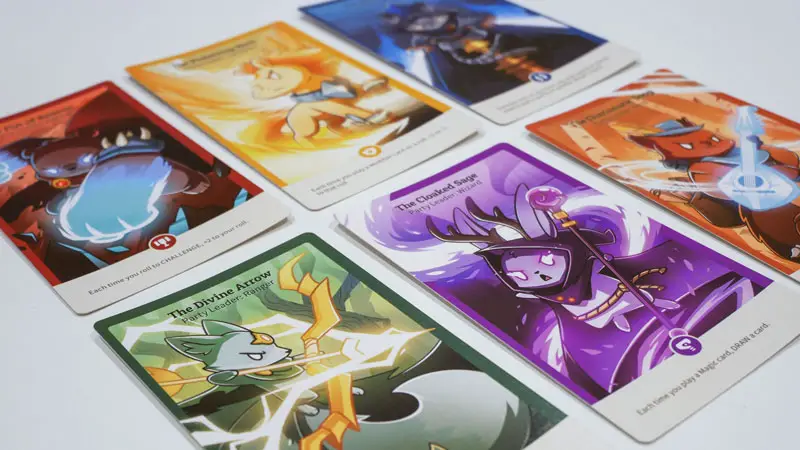
The Party leader cards in the base game are 6 and each of them has a specific class and a skill that provides you with a unique benefit for the entire duration of the game.
The 6 leaders with their unique skill are:
- The Fist of Reason (Fighter) – each time you roll to Challenge, +2 to your roll.
- The Protecting Horn (Guardian) – each time you play a Modifier card on a roll, +1 or -1 to that roll.
- The Divine Arrow (Ranger) – each time you roll to Attack a Monster card, +1 to that roll.
- The Shadow Claw (Thief) – once per turn on your turn, you may spend an action point to pull a card from another player’s hand.
- The Cloaked Sage (Wizard) – each time you play a Magic card, Draw a card.
- The Charismatic Song (Bard) – each time you roll to use a Hero card’s effect, +1 to your roll.
There are a couple of points to bear in mind about party leader cards:
- They aren’t like Hero cards, therefore you can use their skill multiple times during your turn when the conditions to activate the skill are met.
- Your Party Leader card can’t be sacrificed, destroyed, stolen, or returned to your hand; it always remains in your party until the end.
And remember, the Party leader’s class counts towards the winning condition of having 6 different classes in your party.
Note: you may not use The Shadow Claw as your Party Leader card in 2-player games.
The Monsters
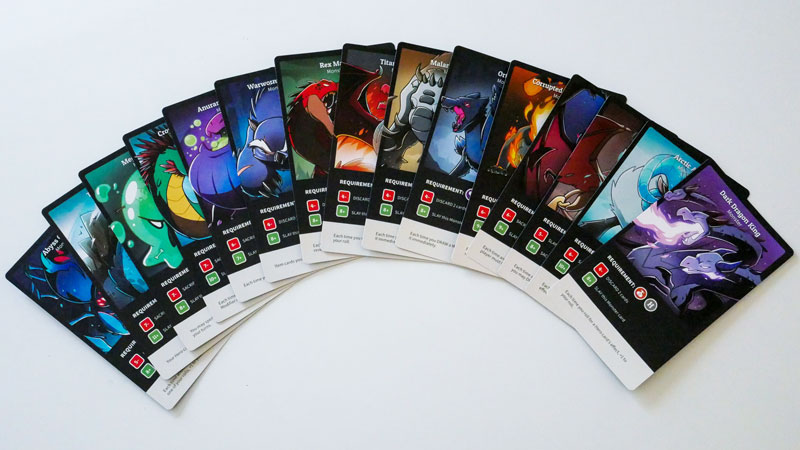
The Monster cards in the base game are 48 and each of them has specific requirements when you want to attack them and a unique effect once you manage to slay them.
On your turn, you can decide to attack any monster at the centre of the table by spending 2 action points.
In order to be able to attack a monster, your party has to meet the requirements written on the monster card.
Some Monsters require you to have a certain number of Hero cards in your Party (represented with the letter “H”) while others may require you to have a certain class in your Party (represented with a symbol) in order to attack that Monster card.
Once you manage to slay a Monster, you acquire that card and its effect.
That card is placed in front of you, next to the Party leader and it can’t be stolen, destroyed, attacked, or returned to your hand.
All the monsters have different effects, more or less powerful, so pick the monster you want to slay with attention.
Conclusion
Is Here to Slay fun to play?
I find that some aspects of the game are very fun, such as reading the cards and thinking about a winning strategy, coming up with powerful combo between cards in order to kill a strong monster and messing up other people’s plans right before they manage to play the last Hero they need for the win.
This is always my number measure when it comes to judging a game and based on what I wrote above I certainly consider Here to Slay very fun to play.
The game doesn’t come without flaws though.
If the number of players is too high the downtime between turns can be really long. I’d recommend a maximum of 4 players for the best outcome!
Components Quality
Not much to say here as the components are just cards, but they are printed on textured paper that seems more premium than the more common paper used for board games. In theory, they should stand the test of time while you face numerous adventures with your friends.
Anyway, I always recommend protecting your cards with sleeves, which is the best way to avoid ruining the edges while shuffling them.
Replayability
Thanks to the rich variety of heroes, monsters and skills, your journey in Here to Slay remains fresh and captivating for many games.
Your party’s composition can be quite different each time you play, therefore your interest in the game should last for a long time.
There are also some expansions you could add to the base game that will also contribute to extending the game’s replayability.
I personally have all of them and the game feels fresh any time I play.
Player Interaction
There are many opportunities to interact with other players since a big part of the game revolves around sabotaging your opponents.
You can steal cards from your friends, give their Heroes cursed items for which you’ll be hated, you can challenge them to mess their strategy up, and so on.
In some circumstances you and some of your opponents can also work together, for example, you could both play modifier cards to block a third opponent from doing a move that would guarantee the win.
I think this is a game where strategy and interaction with friends work very well.
Difficulty
Overall I don’t think Here to Slay is a difficult game to play.
Cards are written in a simple way and most of the time the text to read isn’t too long. I played with different aged people (some were very young) and we didn’t have any sort of issues in reading cards or understanding the rules.
The strategy aspect of the game is quite simplified and therefore I’d definitely recommend the game to families with young children too.
- A Strategic Card Game. A Role-Playing Adventure. A Dangerous New World.
- STRATEGY CARD GAME: Here to Slay is a fast-paced, easy to learn game for 2-6 players, ages 10+! It’s perfect for all skill levels, whether you’re just entering the world of card games or honing your masterful skills and takes 30-60 minutes to play!
- KICKSTARTER FAVORITE: The game was one of Kickstarter’s top 50 most backed projects of all time!
As an Amazon Associate I earn from qualifying purchases, at no additional cost to you. See our Affiliate Disclosure
